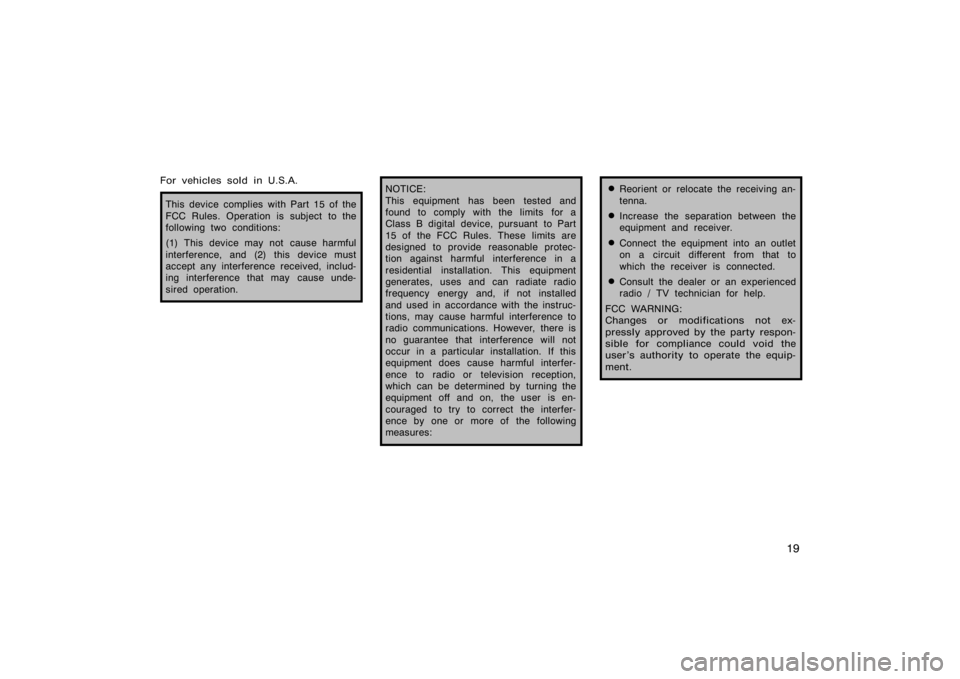Page 6 of 496

vi
New vehicle warranty
Your new vehicle is covered by the following Toyota limited
warranties:��New vehicle warranty
� �Emission control systems warranty
� �Others
For further information, please refer to the �Owner’s
Warranty Information Booklet" or �Owner ’s Manual
Supplement".
Your responsibility for maintenance
It is the owner ’s responsibility to make sure that the speci-
fied maintenance is performed. Section 6 gives details of
these maintenance requirements. Also included in Section
6 is general maintenance. For scheduled maintenance in-
formation, please refer to the �Scheduled Maintenance
Guide" or �Owner ’s Manual Supplement".
Important health and safety
information about your Toyota
CAUTION
�WARNING: Engine exhaust, some of its constitu- ents, and a wide variety of automobile compo-
nents contain or emit chemicals known to the
State of California to cause cancer and birth de-
fects and other reproductive harm. In addition,
oils, fuels and fluids contained in vehicles as
well as waste produced by component wear con-
tain or emit chemicals known to the State of
California to cause cancer and birth defects or
other reproductive harm.
�Battery posts, terminals and related accessories contain lead and lead compounds. Wash your
hands after handling. Used engine oil contains
chemicals that have caused cancer in laboratory
animals. Always protect your skin by washing
thoroughly with soap and water.
Page 8 of 496

viii
Installation of a mobiletwo−way radio system
As the installation of a mobile two−way radio system in
your vehicle could affect electronic systems such as fol-
lows, be sure to check with your Toyota dealer for precau-
tionary measures or special instructions regarding installa-
tion.
��Multiport fuel injection system/sequential multiport
fuel injection system
� �SRS airbag system
� �Seat belt pretensioner system
� �Traction control system (two−wheel drive models)
� �Active traction control system
(four−wheel drive models)
� ��AUTO LSD" system (two−wheel drive models)
� �Vehicle stability control system
� �Downhill assist control system
(four−wheel drive models)
� �Hill−start assist control system
� �Rear height control air suspension
��Tire pressure warning system
� �Cruise control system
� �Anti−lock brake system
� �Electronic throttle control system
Tires and loading on your
To y o t a
Underinflated or overinflated tire pressure and the
excess load may result in the deterioration of
steering ability and braking ability, leading to an
accident. Check the tire inflation pressure periodi-
cally and be sure to keep the load limits given in
this Owner ’s Manual. For details about tire inflation
pressure and load limits, see pages 441 and 364.
Page 18 of 496
6
CY11062
1. Tachometer
2. Speedometer
3. Service reminder indicators andindicator lights 4. Fuel gauge
5. Low fuel level warning light
6. Engine coolant temperature gauge
7. Trip meter reset knob
8. Odometer and two trip meters
Instrument cluster overview
�
Ty p e A
Page 19 of 496
7
CY11067
1. Service reminder indicators andindicator lights
2. Tachometer 3. Speedometer
4. Fuel gauge
5. Low fuel level warning light6. Engine coolant temperature gauge
7. Trip meter reset knob
8. Odometer and two trip meters
�
Ty p e B
Page 20 of 496
8
or
Driver ’s seat belt reminder light∗1
Low engine oil pressure warning light∗1
Engine oil replacement reminder light∗1
(for vehicles sold in U.S.A.) Brake system warning light
∗ 1
Malfunction indicator lamp∗1
Charging system warning light∗1
Anti−lock brake system warning light∗1
SRS warning light∗1
Open door warning light∗1
Front passenger ’s seat belt reminder light∗1Automatic transmission fluid temperature
warning light∗1 (four−wheel drive models)
Tire pressure warning light∗1
Engine immobilizer/theft deterrent system
indicator light
Roll sensing of curtain shield airbags off
indicator light∗2
Low windshield washer fluid level warning
light∗1 (for vehicles sold in Canada)
Front passenger occupant classification indicator
light
Indicator symbols on the instrument panel
Page 21 of 496
9
Slip indicator light
Turn signal indicator lightsDownhill assist control system indicator light
(four−wheel drive models)
Headlight high beam indicator light
Headlight low beam indicator light
Tail light indicator light
�AUTO LSD" indicator light
Four−wheel drive indicator light∗
3
(multi−mode four−wheel drive models)
Center differential lock indicator light∗3
(four−wheel drive models) Automatic transmission indicator lights
Low speed four−wheel drive indicator light∗3
(four−wheel drive models)
Vehicle stability control system off
indicator/warning light∗1
Front fog light indicator light
Cruise control indicator light∗5
Height control �OFF" indicator light∗4
Height control indicator lights
Page 22 of 496
10
∗1: For details, see �Service reminder indicators and warning
buzzers" on page 149 in Section 1−6.
∗2: For details, see �Roll sensing of curtain shield airbags off
switch" on page 95 in Section 1−3.
∗3: If this light flashes, see �Four−wheel drive system" on page
168 in Section 1−7.
∗4: If this light flashes, see �Rear height control air suspension"
on page 191 in Section 1−7.
∗5: If this light flashes, see �Cruise control" on page 203 in
Section 1−7.
Page 31 of 496

19
For vehicles sold in U.S.A.
This device complies with Part 15 of the
FCC Rules. Operation is subject to the
following two conditions:
(1) This device may not cause harmful
interference, and (2) this device must
accept any interference received, includ-
ing interference that may cause unde-
sired operation.
NOTICE:
This equipment has been tested and
found to comply with the limits for a
Class B digital device, pursuant to Part
15 of the FCC Rules. These limits are
designed to provide reasonable protec-
tion against harmful interference in a
residential installation. This equipment
generates, uses and can radiate radio
frequency energy and, if not installed
and used in accordance with the instruc-
tions, may cause harmful interference to
radio communications. However, there is
no guarantee that interference will not
occur in a particular installation. If this
equipment does cause harmful interfer-
ence to radio or television reception,
which can be determined by turning the
equipment off and on, the user is en-
couraged to try to correct the interfer-
ence by one or more of the following
measures:�Reorient or relocate the receiving an-
tenna.
�Increase the separation between the
equipment and receiver.
�Connect the equipment into an outlet
on a circuit different from that to
which the receiver is connected.
�Consult the dealer or an experienced
radio / TV technician for help.
FCC WARNING:
Changes or modifications not ex-
pressly approved by the party respon-
sible for compliance could void the
user’s authority to operate the equip-
ment.